Cat-proofing your home is essential for any cat owner to safeguard your beloved pet from common household hazards while protecting your belongings from their sometimes mischievous paws. Cats are naturally curious and agile, making them prone to exploring high shelves, tight spaces, and even the most secluded corners. Though part of their charm, this exploration can lead to accidents or injuries if your home isn't properly secured. From securing loose wires that pose chewing hazards to ensuring that toxic substances are out of reach, cat-proofing involves a thorough assessment of potential risks in every room. This proactive approach safeguards the well-being of your new cat while helping to preserve a peaceful and undamaged living environment for all.
Cat Proof Your House Room By Room
Living Room
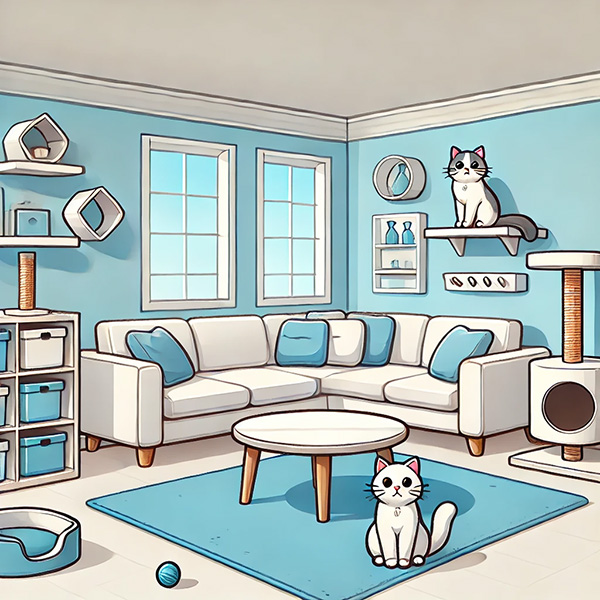
Cat-proofing your living room is critical in creating a safe and enjoyable environment for your feline friend while protecting your belongings. Start by securing or hiding electrical cords and wires. Cats are often tempted to chew on these, leading to electrical hazards or shocks. Consider using cord covers or taping cords to baseboards.
Next, make sure to place fragile items out of reach. Cats are agile and can jump onto shelves and mantels, where they might accidentally knock down valuable or breakable items. Use secure methods to display items or place them in closed cabinets.
Also, ensure there are plenty of designated scratching areas to keep your furniture from being used as a scratching post. Scratching posts or pads strategically placed around the living room will keep your cat's claws healthy and deter them from using your furniture. Select tall scratching posts that allow your cat to fully stretch and are sturdy enough to endure vigorous use.
Kitchen
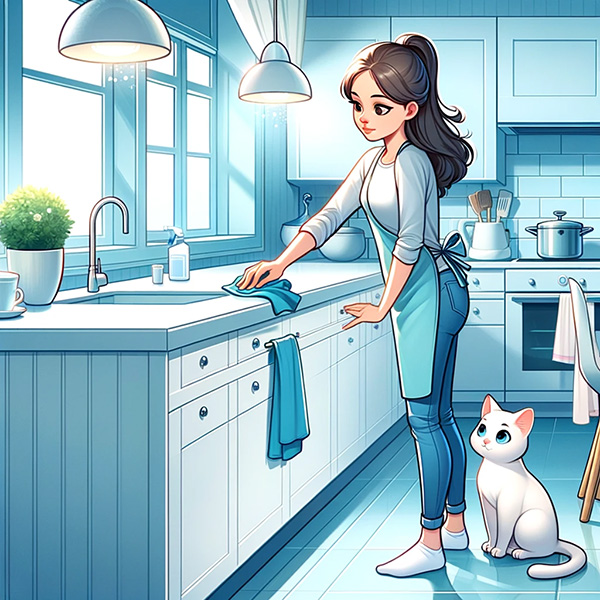
Ensuring your kitchen is cat-proof is crucial to keep your furry friend safe and maintain a clean and secure environment. Begin by securing your trash cans with lids or placing them in a locked cabinet. Cats are curious and may rummage through garbage, exposing themselves to harmful substances or choking hazards.
Additionally, keep all harmful foods, cleaning agents, plastic bags, and sharp objects well out of your cat’s reach. Use high shelves for storage or secure cabinets with child-proof latches to prevent curious paws from opening them and coming into contact with dangerous or toxic substances.
Keep in mind that many common foods and kitchen cleaners, while safe for humans, can be toxic to cats. Implementing these safety measures helps prevent accidental ingestion of harmful materials and ensures your kitchen remains safe for all household members, including your four-legged ones. Taking proactive steps can greatly minimize risks and enjoy a worry-free home environment with your cat.
Bathroom
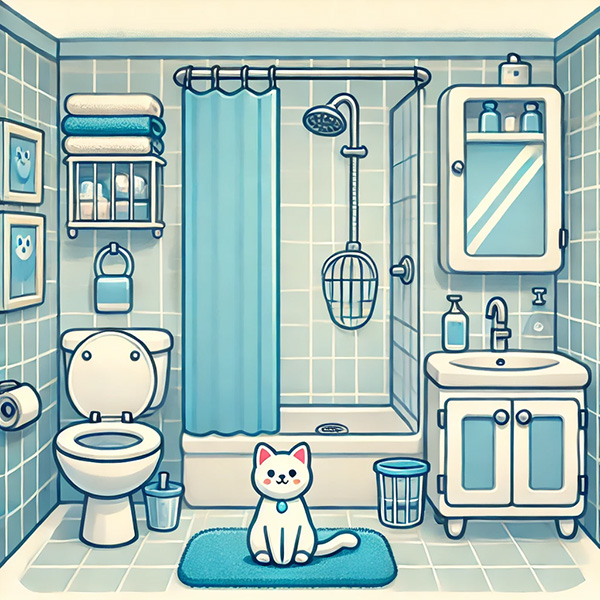
Cat-proofing your bathroom is essential to keep your feline friend safe from common household hazards, as this may most likely be where you will set up the cat litter box. Start by keeping the toilet lid closed to prevent any risk of drowning or falling in, especially for kittens, smaller cats, or curious cats. Additionally, small objects like hair ties, dental floss, and even cotton swabs can be intriguing but dangerous if ingested, leading to possible intestinal blockages. Always ensure such items are securely stored away. If you plan on setting up litter boxes in the bathroom, ensure there are the right number of litter boxes.
It's important to keep all medications and cleaning products stored securely in cabinets. Cats are adept climbers and can often reach surprising heights, so consider installing child-proof latches to prevent access. Avoid leaving toilet bowl cleaners inside the bowl, and refrain from using automatic bowl cleaners. These simple steps help protect your curious kitties from harm and give you peace of mind, ensuring that even the bathroom remains a safe environment for your curious pet.
Bedroom
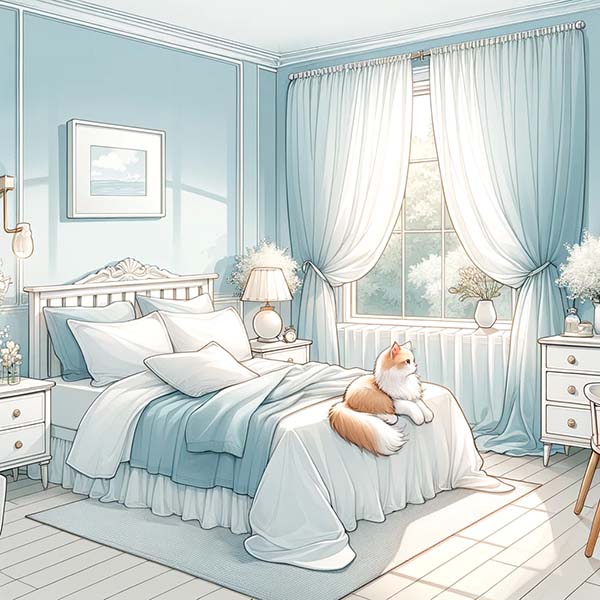
Ensuring your bedroom is cat-proof involves attention to detail to create a safe space for your pet while protecting your belongings. Start by removing small, loose items such as jewelry, coins, or any tiny objects a cat might be tempted to play with or swallow. If ingested, these items can present a serious choking hazard or cause intestinal blockages.
Also, take the time to inspect potential hiding spots where your cat might squeeze into and get stuck or injured. Look under the bed, behind furniture, and inside closets. Secure any loose wires or sharp edges, and consider blocking off areas where your cat could get trapped.
Taking these precautions ensures your feline friend's safety and protects your valuable items from playful paws. Keeping your bedroom free of hazards and providing a secure environment will help keep your cat healthy and give you peace of mind.
Laundry Room and Garage
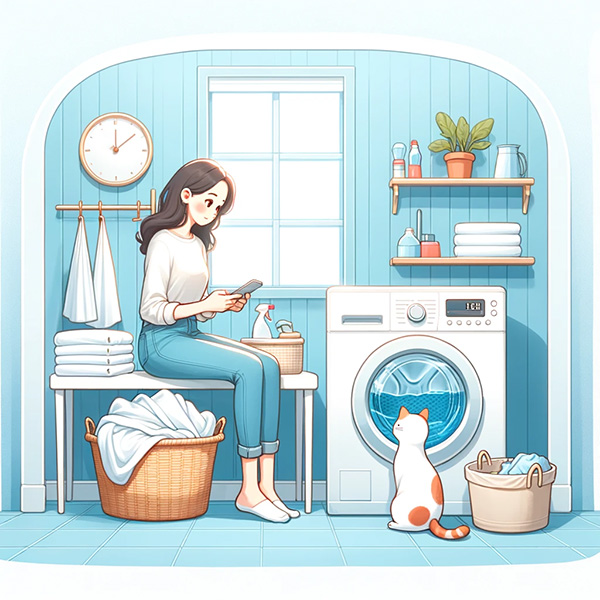
Cat-proofing your laundry room and garage is crucial for protecting your furry family members from potential hazards. Start by always keeping the doors of your washer and dryer closed, and make it a habit to check inside before using these appliances. Cats often seek out hidden, cozy spots for naps, and the warmth of a dryer can be especially enticing, posing a significant risk if the machine is turned on while they're inside.
Additionally, storing hazardous substances such as detergents, antifreeze, or insecticides in secured cabinets is important. These materials can be lethal if ingested by your cat and should always be kept out of reach. Use child-proof locks to ensure that curious paws cannot open cabinet doors. By taking these precautions, you can create a safer environment in areas of your home that might otherwise pose serious risks to your pets. Keep in mind that thinking ahead and preparing can greatly help in safeguarding your beloved cat.
Outdoors and Balcony

Creating a safe outdoor environment for your cat involves several strategic measures. First, installing cat-proof fencing or enclosures is crucial. These structures are designed with features like roller bars or overhangs that prevent cats from climbing over. For balconies, securing durable netting or mesh around the perimeter ensures your cat can't squeeze through or climb over, keeping them safely contained.
Regarding plant safety, eliminate any toxic plants from your garden and replace them with plants that are safe for cats. Poisonous plants such as lilies and rhododendrons are harmful to cats and should be avoided. Instead, opt for safe plants like catnip or wheatgrass, which can provide additional enrichment.
Additionally, it's important to secure areas that might present fall hazards or where your cat could get stuck. Make sure outdoor furniture or decorations are stable and cannot be easily toppled. Balcony railings should be inspected regularly to ensure they are secure and have no gaps that could pose a risk.
Lastly, ensure all garden tools and chemicals, including fertilizers and pesticides, are stored securely out of reach. Regular inspections and maintenance of fences, nets, and storage areas will help prevent accidents and keep your cat safe while it enjoys the outdoors. These proactive steps will not only protect your cat from potential dangers but also provide it with a stimulating and enjoyable outdoor space.
General Tips
Ongoing Inspection
Regularly survey your home from your cat's perspective to spot potential dangers. Look for loose wires, small swallowable objects, or unstable furniture that might tip over. It’s crucial to conceal exposed electric cords and any dangling cords to prevent your cat from chewing and swallowing them. Make sure to meticulously assess every corner of your house because even seemingly minor items could pose significant risks to a curious cat.
Use Deterrents and Protective Measures
In areas where it's impossible to eliminate hazards, completely implement cat deterrents or protective covers. Cord protectors can safeguard electrical wires from cat bites, while furniture covers can protect upholstery. Additionally, placing sticky tape or aluminum foil on certain surfaces can help deter cats from these areas.
Secure Household Cleaners
It's vital to store all cleaning agents in high cabinets or secure them with child-proof latches to prevent your cat from accessing potentially toxic substances. Taking this step is crucial for preventing accidental poisonings and ensuring a safer environment for your cat.
Enrichment and Entertainment
Provide an array of cat toys, cat trees, and scratching options to keep your cat entertained and engaged. This will divert their attention from potentially harmful activities and satisfy their natural instincts to scratch and play. Scratching posts, interactive toys, and puzzle feeders are excellent for maintaining your cat's interest and can significantly enhance their quality of life.
Continuous Improvement
Continually update your cat-proofing strategies to enhance safety and ensure your home is stimulating. This proactive approach helps create a safe and enjoyable space for your cat to explore and thrive, contributing to their overall well-being and happiness.
